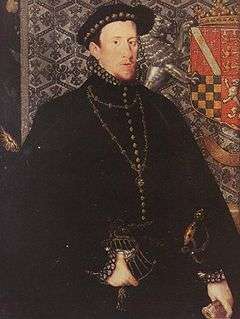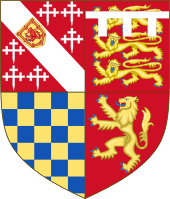Thomas Howard, 4th Duke of Norfolk
| Thomas Howard | |
|---|---|
| Duke of Norfolk | |
 | |
| Spouse(s) |
Mary FitzAlan Margaret Audley Elizabeth Leyburne |
| Noble family | House of Howard |
| Father | Henry Howard, Earl of Surrey |
| Mother | Frances de Vere |
| Born | 10 March 1536 |
| Died |
2 June 1572 (aged 36) Tower Hill , London, England |

Thomas Howard, 4th Duke of Norfolk, KG (10 March 1536 – 2 June 1572) was an English nobleman.
Norfolk was the son of the poet Henry Howard, Earl of Surrey. He was taught as a child by John Foxe, the Protestant martyrologist, who remained a lifelong recipient of Norfolk's patronage. His father predeceased his grandfather, so Norfolk inherited the Dukedom of Norfolk upon the death of his grandfather, Thomas Howard, 3rd Duke of Norfolk in 1554.
Norfolk was the second cousin of Queen Elizabeth I through her maternal grandmother, Lady Elizabeth Howard, and he was trusted with public office despite his family's history and leanings towards Catholicism (although he was brought up a Protestant). It was the 4th Duke of Norfolk who commissioned Thomas Tallis, probably in 1567, to compose his renowned motet in forty voice-parts, Spem in alium.
Marriages and plots
First wife
Thomas Howard's first wife was Mary FitzAlan, who after the death of her brother Henry in 1556 became heiress to the Arundel estates of her father Henry FitzAlan, 19th Earl of Arundel. She died after a year of marriage, having given birth to a son:
Philip Howard (28 June 1557 – 19 October 1595), who became the 20th Earl of Arundel.
It is from this marriage that modern Dukes of Norfolk derive their surname of 'FitzAlan-Howard' and their seat in Arundel. Though her funeral effigy is there, Mary FitzAlan was never buried at Framlingham, but at the church of St. Clement Danes, Temple Bar and then (under the direction of her grandson's will) at Arundel.
Second wife
Norfolk next married another heiress, Margaret Audley,[1] widow of Sir Henry Dudley and daughter of Thomas Audley, 1st Baron Audley of Walden.
Margaret's children by her marriage to Norfolk were:
- Thomas Howard, 1st Earl of Suffolk;
- Lord William Howard, ancestor of the Earls of Carlisle;
- Elizabeth Howard,
- Margaret Howard;[2]
Both Mary FitzAlan and Margaret Audley have their tomb effigies at St Michael the Archangel, Framlingham. [3]
Third wife
After Margaret's death in 1563, Norfolk married Elizabeth Leyburne (1536 – 4 September 1567), widow of Thomas Dacre, 4th Baron Dacre of Gillesland and daughter of Sir James Leyburne.
Norfolk's three sons by his first two wives, Philip, Thomas, and William, married, respectively, Anne, Margaret, and Elizabeth Dacre. The Dacre sisters were the daughters of Elizabeth Leyburne by her marriage to Thomas Dacre and were, thereby, stepsisters to Norfolk's sons.
Public offices
Norfolk was Earl Marshal of England and Queen's Lieutenant in the North. From February to July 1560, Norfolk was commander of the English army in Scotland in support of the Lords of the Congregation opposing Mary of Guise. He negotiated the Treaty of Berwick (1560) by which the Congregation invited English assistance.[4]
Norfolk was the Principal of the commission at York in 1568 to hear evidence against Mary, Queen of Scots presented by Regent Moray, including the casket letters.[5]
Attempted fourth marriage, plots and death
Queen Elizabeth imprisoned Norfolk in 1569 for scheming to marry Mary, Queen of Scots.
Following his release, he participated in the Ridolfi plot with King Philip II of Spain to put Mary on the English throne and restore Catholicism in England. He was executed for treason in 1572. He is buried at the Church of St Peter ad Vincula within the walls of the Tower of London.
Norfolk's lands and titles were forfeit, although much of the estate was later restored to his sons. The title of Duke of Norfolk was restored, four generations later, to Thomas Howard.
In books and film
- Thomas Howard appears as a character in the Philippa Gregory novels The Virgin's Lover and The Other Queen, and in the novel I, Elizabeth by Rosalind Miles.
- A highly fictionalized version of the 4th Duke of Norfolk appears as a villain, played by Christopher Eccleston, in the 1998 film Elizabeth.
- Another version of the Duke is in the BBC mini-series The Virgin Queen, played by Kevin McKidd.
- In the Channel 4 documentary "Elizabeth" (2000) presented by David Starkey, the Duke is portrayed by actor John Gully.
Ancestry
| 16. John Howard, 1st Duke of Norfolk | ||||||||||||||||
| 8. Thomas Howard, 2nd Duke of Norfolk | ||||||||||||||||
| 17. Katherine de Moleyns | ||||||||||||||||
| 4. Thomas Howard, 3rd Duke of Norfolk | ||||||||||||||||
| 18. Sir Frederick Tilney | ||||||||||||||||
| 9. Elizabeth Tilney | ||||||||||||||||
| 19. Elizabeth Cheney | ||||||||||||||||
| 2. Henry Howard, Earl of Surrey | ||||||||||||||||
| 20. Henry Stafford, 2nd Duke of Buckingham | ||||||||||||||||
| 10. Edward Stafford, 3rd Duke of Buckingham | ||||||||||||||||
| 21. Catherine Woodville, Duchess of Buckingham and Bedford | ||||||||||||||||
| 5. Elizabeth Stafford, Duchess of Norfolk | ||||||||||||||||
| 22. Henry Percy, 4th Earl of Northumberland | ||||||||||||||||
| 11. Eleanor Percy, Duchess of Buckingham | ||||||||||||||||
| 23. Maud Herbert, Countess of Northumberland | ||||||||||||||||
| 1. Thomas Howard, 4th Duke of Norfolk | ||||||||||||||||
| 24. Robert de Vere | ||||||||||||||||
| 12. John de Vere | ||||||||||||||||
| 25. Joan Courtenay | ||||||||||||||||
| 6. John de Vere, 15th Earl of Oxford | ||||||||||||||||
| 26. | ||||||||||||||||
| 13. Alice Kilrington | ||||||||||||||||
| 27. | ||||||||||||||||
| 3. Frances de Vere, Countess of Surrey | ||||||||||||||||
| 28. | ||||||||||||||||
| 14. Sir Edward Trussell of Kibbleston | ||||||||||||||||
| 29. | ||||||||||||||||
| 7. Elizabeth Trussell, Countess of Oxford | ||||||||||||||||
| 30. | ||||||||||||||||
| 15. Margaret Dunn | ||||||||||||||||
| 31. | ||||||||||||||||
See also
- Dukes of Norfolk family tree
- John George Howard, a Toronto architect who claims to be related to the Duke.
References
- ↑ "Margaret Howard", National Portrait Gallery
- ↑ http://www.geni.com/people/Margaret-Howard/6000000000151561135
- ↑ "Churchmouse: Framlingham, Suffolk. Church of St. Michael the Archangel". Homepage.ntlworld.com. 2 May 2000. Retrieved 7 September 2012.
- ↑ Calendar of State Papers Scotland, vol. 1 (1898), 323, 440.
- ↑ HMC: Manuscripts of the Earl of Salisbury at Hatfield, vol.1 (1883), p.461.
Further reading
- Edwards, Francis (1968). The marvellous chance: Thomas Howard, Fourth Duke of Norfolk, and the Ridolphi plot, 1570-1572. ISBN 0-246-64474-5.
- "Murdin, William : Collection of State Papers, 1571-1596". London. 1759. papers from Norfolk's treason trial 1568-1572.
- Williams, Neville (1965). Thomas Howard, Fourth duke of Norfolk. ASIN B0007DRE5Y.
- William Cooke Taylor, ed. (2005). Thomas Howard: Fourth Duke of Norfolk. The Benedictine Brethren of Glendalough. ISBN 1-4254-6159-X.
 "Howard, Thomas (1536-1572)". Dictionary of National Biography. London: Smith, Elder & Co. 1885–1900.
"Howard, Thomas (1536-1572)". Dictionary of National Biography. London: Smith, Elder & Co. 1885–1900.
| Political offices | ||
|---|---|---|
| Preceded by The Duke of Norfolk |
Earl Marshal 1554–1572 |
Succeeded by The Earl of Shrewsbury |
| Preceded by The Earl of Sussex |
Lord Lieutenant of Norfolk 1559–1572 |
Succeeded by Unknown |
| Peerage of England | ||
| Preceded by Thomas Howard |
Duke of Norfolk (3rd creation) 1554–1572 |
Vacant Title next held by Thomas Howard |
| Earl of Surrey (3rd creation) 1554–1572 |
Vacant Title next held by Thomas Howard | |
| Baron Mowbray 1554–1572 |
Succeeded by Philip Howard | |